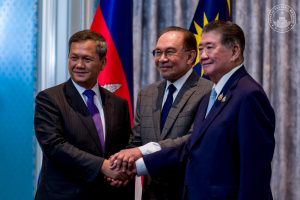U.S. President Donald Trump will visit Malaysia to oversee a formal peace deal between Cambodia and Thailand on the sidelines of the upcoming ASEAN Summit, Malaysia’s foreign minister said on Tuesday.
Cambodia and Thailand engaged in a fierce five-day conflict along their shared border in July, which killed at least 43 people and displaced more than 300,000 on both sides of the border. The two governments agreed to a ceasefire on July 28, but tensions remain high along the border.
Speaking to reporters, Foreign Minister Mohamad Hasan said that Trump will visit the Malaysian capital of Kuala Lumpur on October 26 to witness an agreement between the two countries.
“During the summit, we hope to see the signing of a declaration, known as the Kuala Lumpur Accord, between these two neighbors to ensure peace and a lasting ceasefire,” Mohamad told the media, as per Reuters. He said Trump was “looking forward” to witnessing the deal, although he did not specify whether the U.S. leader would attend any of the ASEAN-related meetings.
The White House has still not officially confirmed Trump’s attendance at the Malaysian summit, although Reuters cited a person familiar with the matter who confirmed that the trip was “being planned.”
The 47th ASEAN Summit and related meetings, which are due to take place in Kuala Lumpur on October 26-28, will bring together leaders from the bloc’s 10 member states as well as its various dialogue partners. Among those who have confirmed their attendance are Brazilian President Luiz Inacio Lula da Silva, South African President Cyril Ramaphosa, and Indian Prime Minister Narendra Modi.
At the end of July, Malaysian Prime Minister Anwar Ibrahim announced that Trump had accepted an invitation to attend the summit. Politico reported last week that Trump was willing to attend, but on the condition that he gets to preside over the ceremonial signing of a peace agreement between Cambodia and Thailand, and that Chinese officials be barred from attending.
Trump played an important role in brokering the ceasefire that ended five days of fighting along the Cambodia-Thailand border in late July, reportedly threatening to withhold tariff relief from the two nations if they did not put down their weapons. He later included the conflict among the “seven un-endable wars” that he claimed to have ended. Despite this, tensions along the Cambodia-Thailand border remain high, and both sides have repeatedly accused the other of violating the July 28 ceasefire, against a background hum of nationalistic social media commentary. Border crossings between the two nations have also been closed since June, and overland trade has come to a standstill.
With Malaysia seeming to confirm Trump’s coming visit, the big question now is what exactly the Kuala Lumpur Declaration will include. Mohamad said on Tuesday that Malaysia and the U.S. would help facilitate a broader ceasefire that would require Cambodia and Thailand to remove all mines and heavy artillery from their borders. However, it is clear from his comments, and those of other involved officials, that the agreement has not yet been concluded. Thai Foreign Minister Sihasak Phuangketkeow told reporters on Tuesday that he would travel to Kuala Lumpur this week for talks, which he said were “moving forward.”
As with the earlier ceasefire deal, the Trump administration has reportedly made a resolution of the conflict a condition of U.S. trade negotiations with Thailand. However, Bangkok says that it will only sign a peace agreement on four conditions: that Cambodia withdraws troops from border positions, removes landmines, cracks down on cyber scam operations targeting Thai residents, and resettles Cambodian citizens whom it claims have encroached into Thai territory.
Any of these could be a stumbling block to an agreement. Of particular contention is the status of two disputed villages on the border between Thailand’s Sa Kaeo province and Cambodia’s Banteay Meanchey province, where the Thai military has erected razor wire blockades. Cambodia claims that the blockades have barred villagers from homes they have occupied for decades, and last month, Thai police fired tear gas and rubber bullets at Cambodian civilians protesting the blockades in one of the disputed villages.
So far, it remains unclear whether the Kuala Lumpur Declaration will amount to anything more than a restatement and elaboration of the July 28 ceasefire and the 13-point plan that Thai and Cambodian officials subsequently agreed on August 7.
Given the extent of the unresolved issues, it is hard to avoid the conclusion that the agreement is being negotiated in order to please Trump more than anything else. While further dialogue between the two sides is necessary, and Trump’s prestige may prevent the two sides from undertaking any actions that threaten the ceasefire, at least in the short term, the two sides are very far from resolving the underlying causes of the conflict, which have remained unresolved since the middle of the last century. They certainly cannot hope to do so in time for Trump’s peace ceremony in Kuala Lumpur.
Pavin Chachavalpongpun, a professor at Kyoto University’s Centre for Southeast Asian Studies, told the Cambodian media outlet Cambodianess that the Trump-hosted peace ceremony “risks overshadowing ASEAN’s central role as the region’s main security forum.” He also said that it risked turning a complex regional process into “a symbolic diplomatic performance designed to boost an American leader’s political image.”





























